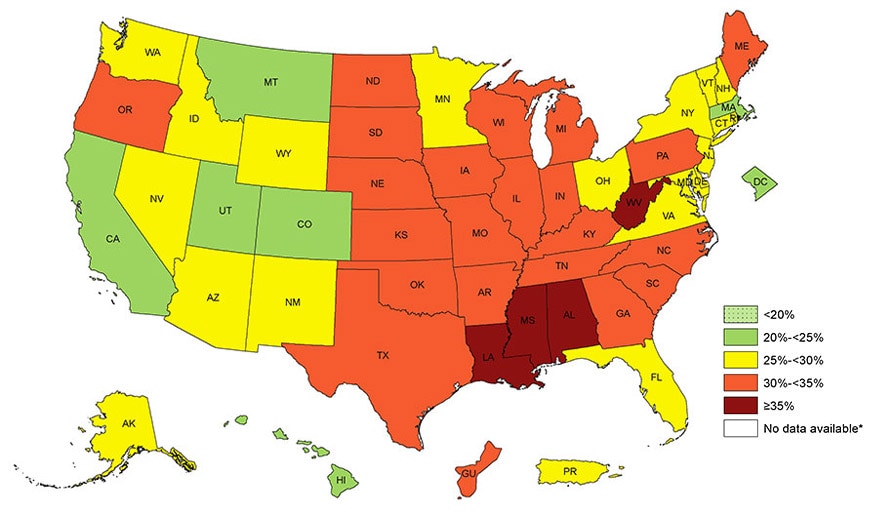What is BMI?
BMI is a person’s weight in kilograms divided by the square of height in meters. BMI does not measure body fat directly, but research has shown that BMI is moderately correlated with more direct measures of body fat obtained from skinfold thickness measurements, bioelectrical impedance, densitometry (underwater weighing), dual energy x-ray absorptiometry (DXA) and other methods. Furthermore, BMI appears to be as strongly correlated with various metabolic and disease outcome as are these more direct measures of body fatness. In general, BMI is an inexpensive and easy-to-perform method of screening for weight category, for example underweight, normal or healthy weight, overweight, and obesity.
How is BMI used?
A high BMI can be an indicator of high body fatness. BMI can be used as a screening tool but is not diagnostic of the body fatness or health of an individual.
To determine if a high BMI is a health risk, a healthcare provider would need to perform further assessments. These assessments might include skinfold thickness measurements, evaluations of diet, physical activity, family history, and other appropriate health screenings.
What are the BMI trends for adults in the United States?
The prevalence of adult BMI greater than or equal to 30 kg/m2 (obese status) has greatly increased since the 1970s. Recently, however, this trend has leveled off, except for older women. Obesity has continued to increase in adult women who are age 60 years and older.
Prevalence of Self-Reported Obesity Among U.S. Adults by State and Territory, BRFSS, 2015

Why is BMI used to measure overweight and obesity?
BMI can be used for population assessment of overweight and obesity. Because calculation requires only height and weight, it is inexpensive and easy to use for clinicians and for the general public. BMI can be used as a screening tool for body fatness but is not diagnostic.
To see the formula based on either kilograms and meters or pounds and inches, visit How is BMI calculated?
What are some of the other ways to assess excess body fatness besides BMI?
Other methods to measure body fatness include skinfold thickness measurements (with calipers), underwater weighing, bioelectrical impedance, dual-energy x-ray absorptiometry (DXA), and isotope dilution 1,2,3. However, these methods are not always readily available, and they are either expensive or need to be conducted by highly trained personnel. Furthermore, many of these methods can be difficult to standardize across observers or machines, complicating comparisons across studies and time periods.
How is BMI interpreted for adults?
For adults 20 years old and older, BMI is interpreted using standard weight status categories. These categories are the same for men and women of all body types and ages.
The standard weight status categories associated with BMI ranges for adults are shown in the following table.
|
BMI
|
Weight Status |
|---|---|
| Below 18.5 | Underweight |
| 18.5 – 24.9 | Normal or Healthy Weight |
| 25.0 – 29.9 | Overweight |
| 30.0 and Above | Obese |
For example, here are the weight ranges, the corresponding BMI ranges, and the weight status categories for a person who is 5′ 9″.
| Height |
Weight Range
|
BMI
|
Weight Status |
|---|---|---|---|
| 5′ 9″ | 124 lbs or less | Below 18.5 | Underweight |
| 125 lbs to 168 lbs | 18.5 to 24.9 | Normal or Healthy Weight | |
| 169 lbs to 202 lbs | 25.0 to 29.9 | Overweight | |
| 203 lbs or more | 30 or higher | Obese |
For children and teens, the interpretation of BMI depends upon age and sex.
For adults, the interpretation of BMI does not depend on sex or age.
How good is BMI as an indicator of body fatness?
The correlation between the BMI and body fatness is fairly strong, but even if 2 people have the same BMI, their level of body fatness may differ.
In general:
- At the same BMI, women tend to have more body fat than men.
- At the same BMI, Blacks have less body fat than do Whites, and Asians have more body fat than do Whites
- At the same BMI, older people, on average, tend to have more body fat than younger adults.
- At the same BMI, athletes have less body fat than do non-athletes.
The accuracy of BMI as an indicator of body fatness also appears to be higher in persons with higher levels of BMI and body fatness. While, a person with a very high BMI (e.g., 35 kg/m2) is very likely to have high body fat, a relatively high BMI can be the results of either high body fat or high lean body mass (muscle and bone). A trained healthcare provider should perform appropriate health assessments in order to evaluate an individual’s health status and risks.
If an athlete or other person with a lot of muscle has a BMI over 25, is that person still considered to be overweight?
According to the BMI weight status categories, anyone with a BMI between 25 and 29.9 would be classified as overweight and anyone with a BMI over 30 would be classified as obese.
However, athletes may have a high BMI because of increased muscularity rather than increased body fatness. In general, a person who has a high BMI is likely to have body fatness and would be considered to be overweight or obese, but this may not apply to athletes. A trained healthcare provider should perform appropriate health assessments in order to evaluate an individual’s health status and risks.
Candela Citations
- Body Mass Index. Authored by: Centers for Disease Control and Prevention. Provided by: U.S. Department of Health and Human Services. Located at: https://www.cdc.gov/healthyweight/assessing/bmi/adult_bmi/index.html. License: Public Domain: No Known Copyright
- Map: Prevalence of Self-Reported Obesity Among U.S. Adults by State and Territory. Authored by: Centers for Disease Control and Prevention. Located at: https://www.cdc.gov/obesity/data/prevalence-maps.html. License: Public Domain: No Known Copyright